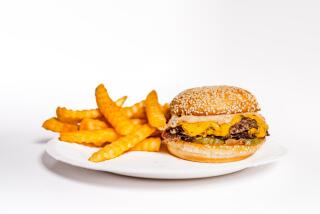Gustav’s Is Tastiest When It’s Traditional : ‘Rock Cuisine’ Falls Flat, but Goulash, Baby Back Ribs Are More Substantial
- Share via
Anaheim was named by German settlers(the name means “home by the Santa Ana river”). Heritage alone owes it a place for good down-home German cooking, and it has such a restaurant in Gustav’s Jagerhaus.
In terms of food, not atmosphere, that is. Gustav’s is on a rather bleak stretch of Ball Road just west of the Orange Freeway, quite easy to drive by. The location used to be a strip mall barbecue pit, and at the outset, Gustav’s does try to work up nostalgia for the Old Country. As you enter, you get an eyeful of a rustic Jagerhaus somewhere in Germany, via black and white photos placed strategically by the door.
Once you are seated in the dining room, though, you could be in Anywhere, U.S.A. It’s a drab room done in pale green and rose pink, with no decor but pewter plates and German beer steins lining a high shelf just below the ceiling. The tables have those easy-clean glass tops, and if you’re lucky, you get a fresh pink carnation to embellish the paper napkins and bargain-basement stainless-steel place settings.
Oh, well. At Gustav’s food prices--bargains themselves--you hardly want to complain.
Hard work is part of the German ethic, so don’t be surprised to learn that this restaurant opens at the ungodly hour of 6 a.m. and stays open clear through dinner. In the morning, you can feast on hearty specialties such as Schwaben omelet (spaetzle, eggs and ham), Austrian pancakes (dense, sweet cakes with raisins in the batter) and the famous golden puff known as German pancake, a whimsical sombrero traditionally eaten with lemon and powdered sugar. Plan to plow a field or two after a breakfast like this one--without a tractor.
The lunch and dinner menus are virtually identical, with two exceptions. At lunchtime, you can get sandwiches, and at dinner, you have the option of something called “rock cuisine.” I’m not sure what the latter has to do with German food, but it is a curiosity. You cook your own food on a flat stone about 10 inches square, which is brought to the table at about 500 degrees Fahrenheit.
The benefits are obvious; greaseless, healthful, low-cal meats and vegetables that you scrape off the rock face and douse with either hot sauce or a vinaigrette furnished by the kitchen. The drawbacks are less obvious. You don’t know this stuff has no flavor until it is too late, not to mention that you can broil your fingers if you aren’t careful. “Don’t touch,” said our waitress as she set the thing down. “Our insurance doesn’t cover you.”
The traditional German dishes are much more substantial and a whole lot tastier, too. Look on the well-endowed specials board for country-style dishes. Szegediner goulash has its roots in Hungary, but the Germans have adopted it as a favorite son. It’s chunked pork stewed with sauerkraut, paprika and sour cream, and I recommend you eat it here with Gustav’s spaetzle, buttery little flour dumplings cut into odd shapes.
The baby back ribs are wonderful too, if you like sauerkraut. What you get is a half slab of tender baked ribs literally smothered in sweet, tangy kraut--a dryish, homemade sauerkraut that is about as far away as the vinegar-infused commercial variety as pumpernickel is from Wonder Bread. The lamb shank is positively enormous. The kitchen smothers it in a rich tomato gravy, perhaps to hide the fact that it isn’t exactly fork-tender.
The regular menu covers most of Germany: the schnitzels of the east, the hunter-style dishes of the south, the assorted sausages. German Combo is a massive plate with Polish sausage, a veal bratwurst and Kassler rippchen, a smoked pork chop. Perhaps my favorite thing to eat in this restaurant would be sauerbraten. Outside Germany, sauerbraten is rarely as sour as the real article, but this one comes close. It’s essentially marinated brisket, and the Jagerhaus smothers it in a thick, yellow-orange gravy. Try it with the homemade mashed potatoes. (Two side dishes come with all dinners.)
This Wienerschnitzel is strictly for Germans. Austrians demand an ultra-thin, crisp version, Frisbee-sized and spilling over the edges of the plate. The Jagerhaus schnitzel employs good white veal but serves it in two thick chunks, with a golden, buttery breading. Jagerschnitzel, by contrast, is pan-fired pork steak in a mushroom cream sauce. I prefer the Austro-Hungarian variant, here called paprika schnitzel. It’s the same meat, sauteed in a paprika sauce with fresh red and green peppers.
Good side dishes such as red cabbage and potato pancakes can make a meal even more filling here, and the Germans certainly love their desserts. Vanilla cake with a chocolate cherry filling passes for Black Forest cake in this restaurant, even though a purist is bound to grumble. (Psst, Gustav. It’s supposed to be chocolate cake.) During the strawberry season, there is a wonderfully heavy strawberry rhubarb kuchen, and let’s not forget apple strudel, a dense interpretation with lots of raisins. All of them are covered with gobs of real whipped cream, just as they would have been when Anaheim first got settled.
Gustav’s Jagerhaus is inexpensive to moderate, and an excellent value in its class. Breakfast is $1.50 to $4.75. Sandwiches are $4.65 to $5.10. German food is $6.25 to $10.45. Rock cuisine is $9.25 to $15.50.
GUSTAV’S JAGERHAUS
2525 E. Ball Road, Anaheim.
(714) 520-9500.
Breakfast 6 a.m. to 11 a.m., Monday through Friday, 8 a.m. to 1 p.m. Saturday; lunch and dinner 11 a.m. to 9 p.m. Monday through Thursday, 11 a.m. to 10 p.m. Friday, 1 to 9 p.m. Saturday and Sunday.
Diner’s Club, MasterCard and Visa accepted.
More to Read
Eat your way across L.A.
Get our weekly Tasting Notes newsletter for reviews, news and more.
You may occasionally receive promotional content from the Los Angeles Times.










